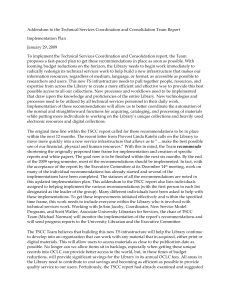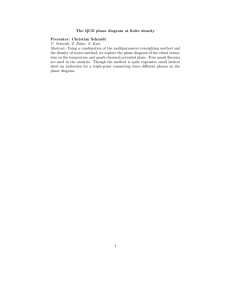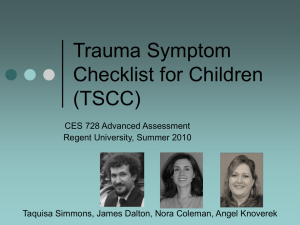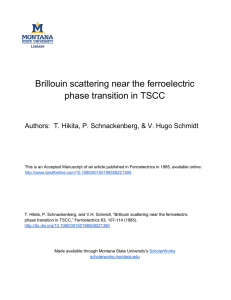Determination of Landau free-energy parameters by dielectric measurements in the ferroelectric TSCC
advertisement
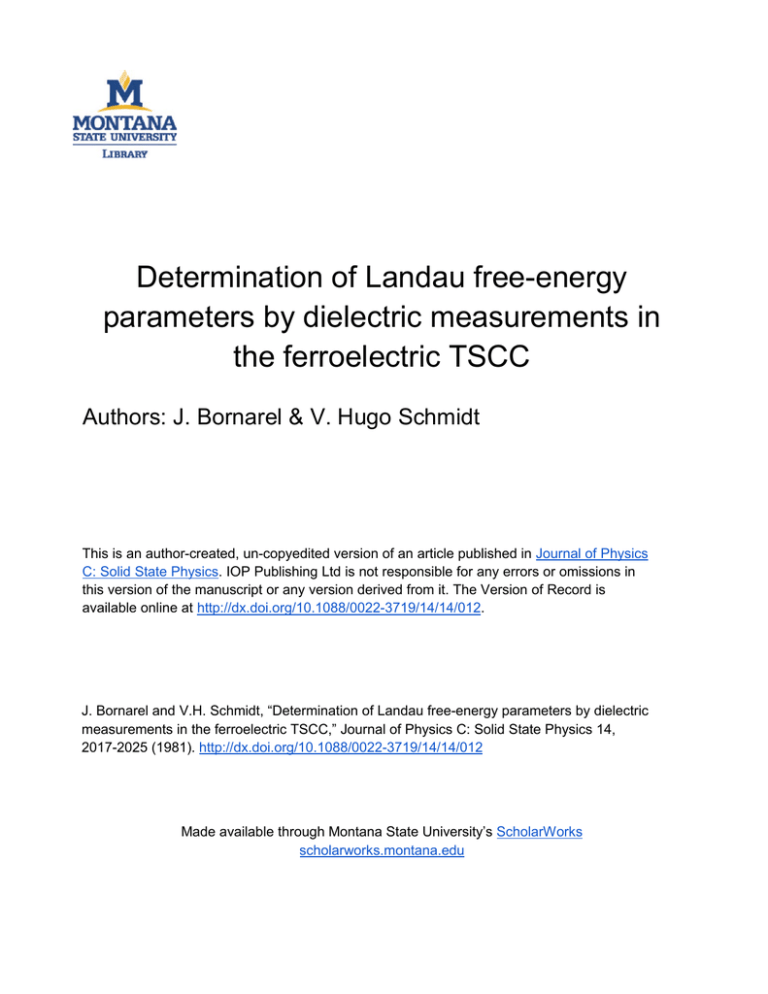
Determination of Landau free-energy parameters by dielectric measurements in the ferroelectric TSCC Authors: J. Bornarel & V. Hugo Schmidt This is an author-created, un-copyedited version of an article published in Journal of Physics C: Solid State Physics. IOP Publishing Ltd is not responsible for any errors or omissions in this version of the manuscript or any version derived from it. The Version of Record is available online at http://dx.doi.org/10.1088/0022-3719/14/14/012. J. Bornarel and V.H. Schmidt, “Determination of Landau free-energy parameters by dielectric measurements in the ferroelectric TSCC,” Journal of Physics C: Solid State Physics 14, 2017-2025 (1981). http://dx.doi.org/10.1088/0022-3719/14/14/012 Made available through Montana State University’s ScholarWorks scholarworks.montana.edu J. Phys. C: Solid State Phys., 14 (1981) 2017-2025. Printed in Great Britain Determination of Landau free-energy parameters by dielectric measurements in the ferroelectric TSCC J Bornarel and V H Schmidt? UniversitC Scientifique et MCdicale de Grenoble, Laboratoire de Spectronittrie Physique (associC au CNRS), Boite Postale no 53X 38041 Grenoble Cedex, France Received 15 August 1980 Abstract. We measured the adiabatic dielectric permittivity &b of tris-sarcosine calcium chloride (TSCC) at 400Hz near the ferroelectric transition for DC bias fields up to S000Vcm-'. We found E= = 4.2 t 0.2, Curie-Weiss constant C+ = 38.3 t 0.3 K, To = 129.4 f 0.1 K, and Landau coefficients A = (2.95 t 0.2) X lo9 V m A-' s-l K-' and B = (3.5 t 0.1) x loi5 V m5 A-3 s - ~ .We observed evidence of an internal bias field as reported previously by others. 1. Introduction Tris-sarcosine calcium chloride (TSCC)has a paraelectric (PE)to ferroelectric (FE) transition near 130 K. Its structure was found (Ashida et a1 1972) to be orthorhombic Pnma in the PE phase, with 2 = 4 formula units of (CH3NHCH*COOH)3CaCl*per unit cell. The FE phase is presumed (Makita 1965) to remain orthorhombic, with space group Pn2'a and 2 = 4.Dielectric investigations of TSCC have already been made by several groups. Such studies at high pressure have partly elucidated the phase diagram. The PE-FE transition temperature T, increases rapidly with pressure (Windsch and Schmidt 1979,1980). A t higher pressure a disappearance (Hegenbarth and Schmidt 1980, Fujimot0 et a1 1980) of the dielectric anomaly was noted. This disappearance was found (Schmidt 1980) to coincide with a transition to a third, probably antiferroelectric (AFE), phase which exists only at high pressure, the common point for the three phases being at 5.03 kbar and 176.8 K. The most extensive dielectric measurements have been made at ambient pressure. The effects of temperature and DC electric field were studied (Makita 1965, Levstiketall975, Sorge and Straube 1979). Thelatter authors investigated also the effect of the amplitude and frequency of the measuring field and reported unusual results for the effect of a DC field E on the dielectric permittivity &b: 'For E smaller than 0.5 kV cm-' the maximum of &b is shifted to lower temperatures, whereas for E greater than 0.5 kV cm-' it is shifted to higher temperatures with dT,/dE = 0.18 & 0.02 K cm kV-'. The shift at low field also depends on the sign of E'. The purpose of the present work was: (i) to clarify if possible this behaviour of E ~ ( ET,) ; t Permanent address: Department of Physics, Montana State University, Bozeman, Montana 59717, USA. 0022-37191811142017+ 09 $01.50 01981 The Institute of Physics 2017 2018 J Bornarel and V H Schmidt (ii) to determine precisely the coefficients of the Landau free-energy expansion from dielectric measurements. 2. Experimental The first sample was taken from a crystal grown by us by the evaporation method from aqueous solution of 98% pure sarcosine and calcium chloride. The second and third samples were from recrystallised TSCC crystals and presumably have higher purity. TSCC crystals generally grow with ferroelastic twins (domains) (Sawada et a1 1977) which are observable under a polarising microscope for light propagating along the U axis. Monodomain portions were cleaved from these crystals and replaced in solution, after which they generally remained monodomain during further growth. Our samples were made from such ferroelastically monodomain crystals by polishing them with wet filter paper to parallelepiped shape with faces perpendicular to crystallographic axes. Dimensions were a = 3.25 mm, b = 2.15 mm, c = 5.95 mm for the third sample, for which the quantitative results reported herein were measured. Gold electrodes were deposited by evaporation on the faces perpendicular to the FE b axis. Electrical contacts to the samples were made by two methods. la1 I bl Figure 1. ( a ) First method for providing electrical contacts to crystal. ( b )Second method for providing electrical contacts to crystal. In the first method, used with the first two samples and shown in figure l(u), the sample was placed on a metallised support. Its upper face was contacted by a copper foil attached to a Teflon block whose position was adjustable to give the desired contact pressure. Spots of silver paste assured good contact of the crystal electrodes to the support plate and the copper foil. A disadvantage of this method is that differential thermal expansion may cause excessive compression along b at low temperature. In the second method, illustrated in figure l(b) and employed for the third sample, a face perpendicular to a rested on an insulating block. Contacts were made by very weak beryllium-copper coil springs attached to the b faces by drops of silver paint, thus achieving a very weak and nearly temperature-independent compressive force along b. The samples were placed in a cell designed for electrical measurements and optical viewing. Temperature was regulated by a heater located on the thermal path between the crystal and a liquid nitrogen reservoir. Helium at low pressure acted as an exchange gas to maintain essentially uniform sample temperature despite radiation losses through Landau free-energy parameters in TSCC 2019 the viewing window. A Eurotherm type 040 temperature regulator provided stability of lo-' K or better, as measured with a Rosemount platinum resistor and i1 Dana 5000 digital multimeter readout. The relative precision of two measurements near T, was of order 0.01 K, but the absolute accuracy was only several tenths of a degree. The dielectric measurements were performed at 400 Hz and 1V RMS with a General Radio type 1673 automatic capacitance bridge. The precision for C was 0.05 pF, and for tan 6 varied from 0.05 for low values of C near room temperature to 0.001 near the transition. A n appropriate circuit permitted application of DC voltages up to t1000 V to the crystal while isolating the measuring bridge from this DC voltage. The experimental procedure consisted in measuring the dielectric permittivity E ~ ( ET,) at a fixed temperature Tfor all of the desired bias-field values E, then repeating the process at other temperatures near T,. The temperature was regulated for several hours at each new value before beginning dielectric measurements, to ensure thermal homogeneity of the sample. Then &b (at 400 Hz and 1V RMS) was monitored after each stepwise change in E until it had remained constant for several minutes, at which time its value was recorded. This procedure eliminated possible errors resulting from transient adiabatic temperature changes of the sample caused by changes in E , changes which would not be noted by the resistance thermometer which was nearby but did not touch the sample. In fact, however, the new values of C and tan 6 generally stabilised within a few seconds after the step change in E . 3. Results The most readily apparent result is the asymmetry relative to applied field of the real part .$(E), of the permittivity. All three samples exhibited at fixed T = T, a sharp peak of EL(E)displaced from E = 0. In addition, the first two samples exhibited a rounded side peak of EL(E)for one polarity only of E . Both of these samples were mounted as shown in figure l(a); one was from a crystal grown from the original solution while the other was from a recrystallised crystal. Accordingly, non-uniform compressive stress rather than crystal perfection seems to govern this asymmetric behaviour. The third sample whose mounting system shown in figure l(b) caused weaker forces, exhibited no side peak; its form was symmetric with respect to a positive field value which gave maximum EL, Such curves for five temperatures near T, are shown in figure 2; the highest value of (more than 1700) is obtained for a temperature of 130.54 K and a field E, of 45 k 5 V cm-', no effect of T on the field E, giving maximum EL is really noticeable. The results can also be plotted in the form EL( T ) for various bias fields as shown in figure 3. First we note that the temperature T,(E) giving maximum E, decreases up to E 2: Ebias = 45 k 5 V cm-' and then increases monotonically for larger E . A similar effect was observed previously (Sorge and Straube 1979) as noted in the Introduction, except that the internal bias field apparently was about 11 times larger than ours. Although T,(E) is expected to be a non-linear function of E as explained in the Appendix, we can note that T, increases by 0.61 t 0.06 K as E increases from 0.14 to 4.65 kV cm-', which is comparable with the result dT,ldE = 0.18 t 0.02 K cm kV-' quoted previously (Sorge and Straube 1979). Finally we note that the peak value of EL first increases with E and is largest for the 46.5 V cm-I curve, after which it decreases monotonically with increasing E. The peak becomes broad and ill-defined at the highest fields used. 2020 J Bornarel and V H Schmidt -5 -1 I 1 E (kV cm-'l 5 Figure 2. AC (adiabatic) permittivity versus applied DC field E at five temperatures ; (0) = 130.764 t 0.005 K , (0)= 130.94 t 0.01 K, ( 0 )= 131.07 i: 0.01 K, (U) = 131.33 -C 0.01 K, (+) = 132.055 i. 0.002 K. Note displacement caused by effective internal bias field of -45 t 5 V cm-'. 4. Discussion We analyse our results in terms of the Landau-Devonshire free energy 1 F = iAotP2 + -B2nP2n- EP 2n (1) in which P is the polarisation, t = T - TOwith Tobeing the Curie-Weiss temperature which is also T,for non-first-order transitions as studied here, andAoand Bznare positive constants. If n = 2 we have a second-order transition while if n = 3 the transition is at a tricritical point. From the development based on equation (1)given in the Appendix it is easy to see , tmwith field E allow determination of n and Bz,,if only one that the variations of U&,!,and P2" term plays a preponderant role as assumed in equation (1). We accordingly made the logarithmic plot ofl/& versus Eshown in figure 4. Between 1and 5 kV cm-' the slope is 213 as predicted for n = 2, so that no terms of order higher than p i n the free energy are necessary in the range of Eand Tcovered in this experiment. Landau free-energy parameters in TSCC I 202 1 I I do I 1i1 TlKl Figure 3. AC (adiabatic) permittivity CL versus temperature T for thirteen applied DC fields having magnitudes in V cm-' of 0 (A), 46.5 (B), 139.5 (C), 232.6 (D), 325.6 (E), 465 (F), 651.2 (G), 930.2 (H), 1395 (I), 1860 (J), 2791 (K), 3721 (L), 4651 (M). Note that highest peak occurs for curve B for which the applied field apparently cancels the internal bias field. ++ ++/ + +/' 10-3 01 0.5 E i k V cm-') 5 Figure 4. Logarithmic plot of inverse of peak adiabatic permittivity field E , with line of slope 213 for comparison. (E;)-' versus applied J Bornarel and V H Schmidt 2022 It remains to determine AoTo, and B4 (henceforth called B ) in equation (1). To find A . and Towe use the law Eh = E:, + C+/(T- T") in the form Ao( T - TO)= (&I, -E;)-' where C+ = (AoQ)-'.Then a plot of (EL -&)-l versus T yields A. as the slope and To as the intercept. We find EL =4.2 & 0.2, C+ = 38.3 K, A. = (2.95 k 0.2) X lo9 V m A-ls-' K-' and TO= 129.4 _t 0.1 K. To find B we plotted ( l / ~ h )as~ a' ~function of E in figure 5, for which the slope is proportional to B'1'2 as shown in the Appendix. After subtracting the adiabatic correction B' -- B , we found B = (3.5 0.1) x V m5 A-3 s - ~ . * '1 + c + f 0 1 2 3 EikV cm-'1 i 5 Figure 5 . Plot of -312 power of peak adiabatic permittivity. versus applied field E , having slope proportional to Landau coefficient B plus an adiabatic correction term (€3' - B). The other law developed in the Appendix, giving t, = T, - To as a function of E , is much less precise experimentally for two reasons. First, TOis not known precisely enough, and second, t, is difficult to establish exactly from figure 3. By way of contrast, 7'0does not appear in the &;(E)law and E; can be measured much more precisely than t,. Nevertheless, the law tm = 3B'1'34-2'3Ai1E2'3 using the values of A0 and B' found above is in approximate agreement with experiment. The above method is equally useful for calculating the coefficient C (or B6 here) of the p6 term in the free energy if that term becomes predominant over the term. The slope in figure 4 then becomes 415 instead of 213, as was found experimentally (Bornarel and Troussaut) for KH2P04 for applied fields above 4 kV cm-'. For TSCC the iCp6 term with the value of C found previously (Sorge and Straube 1979) contributes only a few per cent at the right side of figures 4 and 5 , and fields above 80 kV cm-' would be necessary to make this term predominate! Values found by various workers for Ao: B and C are shown in table 1. There is a large variation in values of Ao whose origin is not clear. The value of B differs from those found by others (Makita 1965, Sorge and Straube 1979), but their values were found from the spontaneous polarisation curve values assuming that B is independent of temperature over a wide temperature range, while our B is determined from measurements near T,. Our method not only has this advantage of determining B (or C) over a 2023 Landau free-energy parameters in TSCC narrow temperature range; it also does not require previous or simultaneous determination of A . and T , except in determining the adiabatic correction. The fractional adiabatic correction (B’ - R)/Bis rather small (0.173) for TSCC; for crystals like KH2P04 in which it is about 50 times larger (Western and Schmidt 1976), isothermal susceptibility values would be necessary for accurate determinations of B by the method presented in the Appendix. Table 1. Free-energy parameters Ao,B and C for TsCC. Reference Ao B (IO9V m A-’s-I K-’) Makita (1965) Levstik et a/ (1975) Sorge and Straube (1979) Fujimoto er a/ (1980) Schmidt (1980) This work 1.9 i: 0.1 6.61 1.94 2 0.04 2.98 3.65 f 0.2 2.95 2 0.1 4.6 C V m5A-3 s - )~ (10’’ V m9A-5s - ~ ) * 0.4 4.4 f 0.1 1.4 i. 0.2 3.5 t 0.1 Figure6. Sketch of projection along a axis of typical ferroelastically polydomainTscCcrysta1, showing b axis direction for monodomain portion cleaved from this polycrystal. The asymmetry along b could give rise to defect or impurity gradients which could cause the observed effective internal bias fields. Several questions remain open after these measurements. First, what is the origin of the internal bias field observed by us and others (Sorge and Straube 1979)? Further studies are desirable with crystals having various concentrations of impurities, taking into account also the relation between the sign of the bias field and the direction of the surface perpendicular to b of the ferroelastic monodomain cleaved from the parent polydomain crystal, as shown in figure 6. In this connection, optical viewing along the 2024 J Bornarel and V H Schmidt a axis during application of DC fields is desirable to ensure that the fields do not create new ferroelastic domains in the originally monodomain samples. A second question is the origin of the downturn of the (u&)~'*versus E curve in figure 4 at small U&. One would expect a rounded minimum resulting from a defectinduced distribution of Tc'srather than the observed pointed minimum. Finally, what is the effect of pressure on B? Does it remain positive up to the three-phase common point at 5.03 kbar (Schmidt 1980), corresponding to the PE-FE transition remaining of second order? Similar measurements under hydrostatic pressure are desirable to answer this question. Acknowledgments The authors wish to thank R Mainguenaud and C Villeneuve for very able technical assistance and Pr Lajzerowicz for fruitful discussions. Appendix We present here a calculation of E; and t, as functions of E , for a Landau free energy of the form 1 F = &AotP2i-B2,,P2%- E P , 2n where t = T - To, and EL and tm are for a given field E the maximum real dielectric permittivity and the temperature (less TO)at which this maximum occurs. By differentiation one obtains the equation of state E = AotP + BZnPZn-l, (A21 which after a second differentiation yields the inverse isothermal susceptibility xF1= Aot + (2n - 1)BznP2"-'. (A31 Since we are looking for ELand t, for curves of fixed DC field E , the total derivative of equation ( A 2 )yields dP/dt = + (2n - 1)B z , , P ~ ~ - ~ ] . -A$/[Ad The maximum xr occurs where dXF1/dt = A0 + (2n - 1) (2n - 2) B z , , P ~ dP/& ~ - ~ = 0. Substitution of equation ( A 4 )into equation (A.5)yields A o t , ~= (2n - 1) (2n - 3 ) BZ,Pg-2, (A41 (A51 (A61 which together with equations ( A 2 )and ( A 3 )yields tmr= 3B1/3E2/3/24'3Ao, -1 - 3B1/3E2/3/21/3 XmT - 9 (A71 (A81 for n = 2 and B2n= B as required for our analysis. The approximation = 1 + %/EO= xi& is sufficiently accurate for this study. Because our measurements were Landau free-energy parameters in TSCC 2025 made at 400 Hz, we determined the adiabatic susceptibility XS, which is related to xr by xi1= xF1+ TCp1[(8E/8T)pI2, (A91 (Jona and Shirane 1962), where CPis specific heat per unit volume at fixed P. Using equations (A2) and (A3) we obtain xi1 = Aot + (3B + TA&'Cp) P2 for the n = 2 case. From here on we will suppress the subscript S. WithX?' replaced by this xi' in the foregoing analysis, equation (A6) becomes Aotm = 3BPk + 2AoT&,/(Cp -A&,), (All) but the A P i term in the denominator can be neglected because AoPk/Cp==O.0003 for the largest field used in this study. Then the analysis proceeds as before, giving E = 4B(1 + T&&'2CpB) P i = 4B'P$ (A121 Using the fact that for TSCC a binomial expansion of the factor in parentheses is justified, we find that the equivalents of equations (A7) and (A8) for adiabatic tm andxi' have the same form but with B replaced by B'. The value of B' - B is 0.606 x lo1' V m5 A-? sK3, where Cp is calculated using the heat capacity per unit volume of 55 cal mol-' K-l just above T, (Makita 1965) and the density of 1.53 g cm-j quoted (Ashida et a1 1972) for TSCC. References Ashida T, Bando S and Kakudo M 1972Acta Crystallogr. B28 1560 Fujimoto S, Yasuda N, Takagi K, Narayanan P S and Bhat H L 1980J . Phys. D: Appl. Phys. 13 L107 Hegenbarth E and Schmidt B 1980 Ferroelectrics 25 359 Jona F and Shirane G 1962 Ferroelectric crystals (New York: Pergamon) p 39 Levstik A , FilipiE C and Blinc R 1975 Solid State Commun. 18 1231 Makita Y 1965J. Phys. Soc. Japan 20 2073 Sawada A , Makita Y and Takagi Y 1977J . Phys. Soc. Japan 42 1918 Schmidt V H 1980 Solid State Commun. 35 649 Sorge G and Straube U 1979 Phys. Stat. Solidi (a) 51 117 Western A B and Schmidt V H 1976 Solid State Commun. 19 885 Windsch W and Schmidt V H 1979 Bull. Am. Phys. Soc. 24 507 -1980 Ferroelectrics 30 to appear I14
